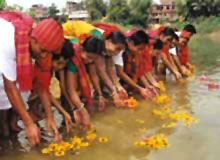Quite a handful of tribal communities reside in every hook and corner of the state of Tripura state. Amongst them, the name of the Halam tribes deserves mentioning. There are eminent anthropologists who have carried on researches on the lives of these Halem tribes. As a result , they have been able to throw some lights on the lives of these Halem tribes . Some of them even have identified these Halam tribes in diverse names like Malsum .
The origin of these Halam tribes has also got an important story behind it. The ardent belief of the anthropologists is that these Halam tribes originally have been descended from one of the tribal groups of the Kuki tribes.
If one wants to study the societal structure of the Halam community, one can easily decipher that it has been segregated into numerous subgroups. These include Kalai and Rupini.
 Following the trend of most of the other tribal communities of the Indian subcontinent, these Halam tribes too are oriented to religion and other spiritual practices. . Priests hold a special significance in the whole of the Halam tribal society. He till date acts a custodian of preserving ancient religious practices and norms.
Following the trend of most of the other tribal communities of the Indian subcontinent, these Halam tribes too are oriented to religion and other spiritual practices. . Priests hold a special significance in the whole of the Halam tribal society. He till date acts a custodian of preserving ancient religious practices and norms.
Maximum of these Halam tribes also are the followers of the Hindu religion. Although these halam tribes have the treasures of their own religious practices and beliefs, nowadays, most of them were largely molded by the practices of the Hindu religion. However, these Halam tribes practice Sakti Cult. Vaishnavism is also practiced with immense devotion and veneration by quite a handful of Halam tribe.
.
The type of worship adept by these Halam Vaishnavis are same as that of Hindus, but they are; animistic` who also religiously believe in the presence of God in all the components of nature. Spiritualism too is in vogue amongst this Halam tribal community. According to these Halam tribes, every place on Earth is holy as they are `the seats of either good or bad spirits`. Thus it becomes very essential to appease these spirits so that these Halam tribes are being protected from various types of disasters and calamities like failure of crop, famine, flood, or epidemic.
This Halam tribal community has a plethora of gods and goddesses .
Matai-Katar is the principal deity of the state of Tripura as identified with Siva Mahadev. The word Matai means God and Katar mean great or supreme. Halam tribes too worship her.
Lam-Pra ,San-Grama ,Uima or Ganga, Mailu-ma , Khuluma , Burha-cha ,Bani-rao and Thari-rao - sons of Burha-cha are also some of the significant deities that are widely revered by these Halam tribes.
Festivals and fairs are part and parcel of these Halam tribes thereby enriching the tradition and culture of the whole society. What is also interesting about these Halam tribes is that though they have the tradition of feting all the festivals of national importance, these Halam tribes have integrated their indigenous customs and norms to it. For example, The two brothers Goraiya and Kataiya are revered on Chaitra Sankranti , i.e. the last day of the Hindu year.
Amongst various religious festivals , Bara puja is the main festival of the Halam tribes which is organized once in four or five years with great splendor and vivacity.
 The other two significant `pujas` feted by both tribal and the non-tribal people, including the Halam tribes , are namely Kharchi puja and Ker puja. The Kharchi is feted for a week in the month of Ashada (June to July) mainly at `puran Agartala` before all the fourteen gods.
The other two significant `pujas` feted by both tribal and the non-tribal people, including the Halam tribes , are namely Kharchi puja and Ker puja. The Kharchi is feted for a week in the month of Ashada (June to July) mainly at `puran Agartala` before all the fourteen gods.
Fourteen days after the Kharchi puja, the Ker puja is feted . In fact this puja is a must for all the Halam tribes . Ker Puja has got a history behind it. Actually it was started by the kings of the Tripura and is feted in the Bengali month of Ashada with a vision to ward off all threats. Amongst these Halam tribes special rules are being ardently followed till date.
During the Ker puja, all entrance to the capital city , Agartala , are blocked for 2 days and a half. At the time of the fest, each and every one including the king, is subjugated to several limitations. For example, all people are bound to stay in their houses, and are permitted to go outside only two times and that too for a only a couple of hours. Other restrictions include no permission for putting on shoes, to ignite a fire. To top it all , these Halam tribes also are barred from doing any kind of dancing and singing All who breach these norms are bound to pay fines. However, over the years, these changes have been brought in by these Halam tribes and limitations also have become quite less.
















